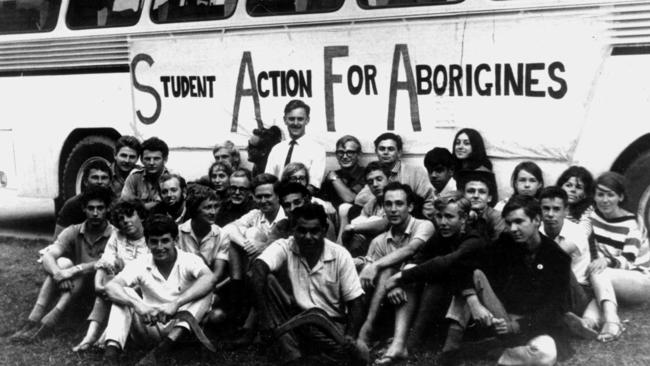Freedom Riders defied hate to end bathing ban
FIFTY years ago today a bunch of students from University of Sydney decided to tackle racial discrimination head-on. What happened next made headlines across the country.

Today in History
Don't miss out on the headlines from Today in History. Followed categories will be added to My News.
Abus was scheduled to leave Sydney University at 7am today, to re-enact one of the most daring events in the history of race relations in Australia. The Freedom Ride of 1965 was a bus tour by 30 Sydney University students that took in numerous outback towns in NSW.
It aimed to highlight racial discrimination and find out the true nature of life as it was experienced by Aboriginal people in remote areas. Setting off on February 12 and returning on February 26, 1965, the Freedom Ride garnered growing media attention as it visited towns including Wellington, Dubbo, Gulargambone, Walgett, Moree, Inverell, Tenterfield, Bow-raville, Kempsey and Taree.
The student organisers called themselves Student Act-ion For Aborigines. SAFA’s leader was Charles Perkins, a 29-year-old who would become Sydney University’s first indigenous graduate, a champion of race rights and a senior federal public servant. Others included 21-year-old Jim Spigelman, a future judge who now chairs the ABC.
SAFA’s Freedom Riders would be spat on, pelted with stones, arrested and even run off the road.
But the students faced probably their most perilous moments 50 years ago on Friday, when their bus rolled up to the Artesian Baths and Olympic Pool in Moree. The pool banned Aboriginal people.
Several days earlier, on February 17, Perkins had rounded up 27 of Moree’s indigenous kids and taken them to the pool on the SAFA bus. A peaceful protest by the other students on the bus had forced pool management to let Perkins and the kids in for a swim.
By the Friday, however, the local council had reinstated its racial ban. With the bus once more on its way to the pool, this time with nine indigenous children on board, a crowd of whites gathered outside the facility.
“I have never met such hostile, hate-filled people,” one of the students, Ann Curthoys, wrote in her diary that night.
Eddie Pitt, then 14, was one of the indigenous children brought to the pool on the SAFA bus on the Friday. “It was terrifying,” he recalls. “There was a big crowd at the pool waiting for the bus to arrive, and it was a very hostile crowd.”
What happened next was reported by the Daily Mirror: “White women jeered and spat at girl freedom riders today as racial violence broke out for the first time at Moree.
“The students were pushed and carried from the front door of the Moree baths while an angry crowd of 500 booed and catcalled.”
Fist fights broke out, a local identity known to support the Aboriginal cause was dumped into the gutter, and eggs and tomatoes whizzed at the students.
Mayor William Lloyd and baths manager Don Ford were both outside the baths, and refused to let the indigenous kids in.
As townspeople started demanding to be let in to cool off, police tried to clear the crowd.
“Medical student Chris Page, 20, from Castlecrag, was pushed to the ground, the Mirror reported.
“Then two council employees carried him bodily from the baths when he refused to move.
“Ald Lloyd then grabbed several students by their shirts and pushed them from the doorway while the crowd cheered.”
Plain clothes police circulated in the crowd to prevent major violence. The Mirror reported one resident as saying: “The students will be in real trouble if they are still here when the pubs close tonight.”
Curthoys wrote in her diary: “The police came up and warned us that if we stayed the violence would get much worse. We decided to stay, continuing to insist on being allowed to enter the pool with the Aboriginal children.”
Then there was a sudden breakthrough. The mayor and three aldermen offered to put a motion to rescind the colour ban, and the students voted unanimously to accept. By now it was evening and the students, under police escort, walked away from the pool and back to the bus.
“That was possibly the worst part,” Curthoys wrote. “We walked single file though the crowd who threw eggs, tomatoes, stones, and spat at us. We bundled into the bus and closed all the windows. ... About 30 cars tried to follow us but the police stopped them.”
That night the students stayed in Inverell. “I was absolutely exhausted. Took two aspirin and flaked out but apparently quite a few stayed up late drinking coffee. We got first place in the 11 o’clock news,” Curthoys wrote.
The ban on Aboriginal people at Moree pool was formally lifted on May 25, 1965.
Charles Perkins died in 2000. In his 1975 autobiography, he wrote: “The Freedom Ride was probably the greatest and most exciting event that I have ever been involved in with Aboriginal affairs. It was a new idea and a new way of promoting rapid change in racial attitudes in Australia.”
Originally published as Freedom Riders defied hate to end bathing ban


